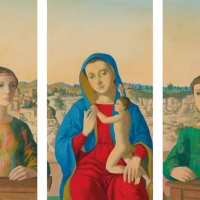68. JUSTIN O'BRIEN

The last years of Justin OBriens life, from 1989 to 1996, saw a decline in his health paralleled by a refinement of the serenity towards which he had aspired during his entire career as a painter. In 1989, he was diagnosed with prostate cancer and travelled from his home in Rome to Sydney for treatment. For several months here he visited Margaret Olleys house in Paddington making drawings of her interiors and garden that would become transformed into paintings for his next exhibition at Australian Galleries later in 1990.
Returning to Italy after that exhibition he continued to produce interiors, nude studies, still-life, flower pieces, landscapes, and portraits, but no painting represents his quest for peace and tranquility more poignantly than Madonna with Two Donors of that year. Framed to appear as a triptych, or predella, it marks a return to his classic attunement of quiet symmetry, with the Madonna and child holding the centre of the composition, flanked by two youthful figures: a girl on one side, a boy on the other.
These donors are not bearing gifts as they tend to do in OBriens earlier Madonna subjects, but simply paying respect with calm dignity to the Virgin for bringing the Christ-child into the world. Curiously, the poses of both are identical but inverted, much like the Rorschach effect of the Madonna del Parto in Monterchi, OBriens favourite painting by Piero della Francesca (1415-1492). He was soon to see that mural once more three years later, cleaned and restored to its former glory.
A number of interiors he painted around this time, including compositions from inside Margaret Olleys house and the windows of his flats at Via Alberico and Via Orazio in Rome, exemplify his fascination for looking out from inside. Indeed, the triptych effect created by a frame in Madonna with Two Donors gives the impression of seeing the figures through a set of windows. The three protagonists are looking in at us as we look out at them.
Im interested in the way representations of looking out from a room enable you to convey a feeling of three-dimensional space. Im just back from my first trip to Holland and I saw that Vermeer and others were fascinated by the same thing1
However, the sheer tranquility of this painting, no doubt constructed, as always through a careful grisaille drawing of Vermeer-like precision, is evoked by a sublimely simple background landscape. No more the forbidding peaks and cliffs of Duccios Maesta in Siena which OBrien had visited on numerous occasions to reassure himself of its mystical intensity, nor the rocky edges of the Greek Island Skyros which had reinforced an exaggerated reading of his earlier style as Byzantine.2
A translucent sky imparts upon the low, gently contoured horizon, an equanimity commensurate with the mood of his paintings of the last six years. It is probably based on drawings OBrien created at Lake Trasimeno in Umbria whilst holidaying with his adopted family Egidio and Daniela Scardamaglia and their two children. Daniela, as she did for so many of OBriens female subjects, probably modelled for the placid image of the Madonna.3
The two donor figures are inspired by the gracefully restrained portraits of Raphael, himself ironically a native of Umbria, and about whose work OBrien was madly passionate. The birth of two daughters to the Scardamaglias, Flavia and Giulia, for whom OBrien became godfather, was also a prime reason he decided to spend his final years in Rome rather than return to Sydney. He adored them from babyhood, paradigms of angelic innocence.
The year before he died, he declared emphatically:
Why does the whole world have to be full of horror? Its not what the whole of life is about. Our beautiful movements should be more important than our ugly movements.4
I think of it perfectly normallyI was born. Ive lived. And I have to die anyway. But it doesnt frighten me.5
OBrien may have had a fluctuating relationship with his Catholic faith, but this masterful triptych suggests a certain aura of rapprochement, an ultimate recognition of the steadying influence of that faith against the skepticism of a painfully sensitive personality.
Footnotes:
1. Justin OBrien to Desmond OGrady, Rome 1986, cited in Pearce, B. & Wilson, N., Justin OBrien: The Sacred Music of Colour, Art Gallery of New South Wales, Sydney, 2010, p.192
2. OBrien travelled to Skyros with Jeffrey Smart in 1964, joined later by Brian Dunlop. In 1967 OBrien and Dunlop returned there, joined by various others. On the question of Byzantine influence, see Grishin, S., Justin OBrien: A Survey Exhibition, Philip Bacon Galleries, Brisbane, 2006, pp.5-9
3. Egidio Scardamaglia was OBriens protg and assistant, whom he had met whilst executing a mosaic commissioned in Israel in 1968. Egidio married fellow art student Daniela Ciccarelli in 1980. Daughters Flavia and Giulia were born in 1983 and 1986 retrospectively.
4. OBrien to Sue Smith, Brisbane, 1995, quoted in Pearce, B. & Wilson, N., op. cit. p.170
5. OBrien to Margaret Throsby, Sydney, 1995, quoted in Pearce, B. & Wilson, N., op. cit. p.170
Barry Pearce
Barry Pearce is Emeritus Curator of Australian Art at the Art Gallery of New South Wales. He is responsible for many exhibitions and publications and is the author of Brett Whiteley: Art & Life (1995) and Sidney Nolan: Retrospective (2007).